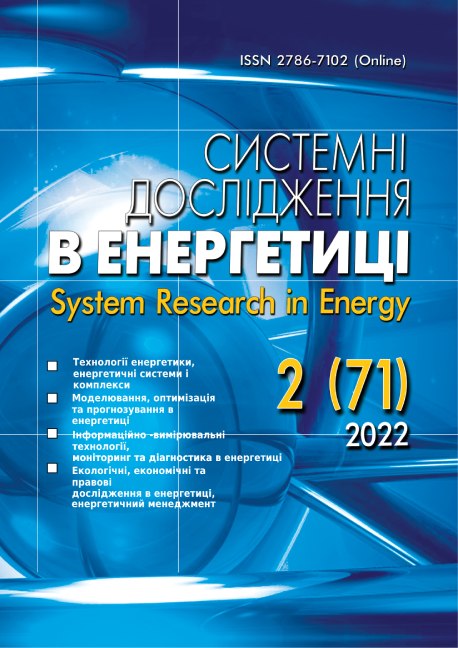The most significant results of fundamental and applied research of General Energy Institute of National Academy of Sciences of Ukraine
The most significant results of fundamental and
and applied research of the Institute of General Energy of the National Academy of Sciences of Ukraine, obtained in 2024
A methodology for analyzing and managing the dynamic processes of joint operation of renewable energy sources (RES) and electric heat generators in an integrated power system (IPS) was developed. For the first time, a mathematical model of frequency and power stabilization in transient processes of an IPS with solar (SPP) and wind (WPP) power plants has been developed, which provides for nonlinear constraints on the generator-regulator power gain rate, degradation of energy storage facilities, their power level, and the zone of insensitivity. This makes it possible to ensure the regulatory requirements for the stability of the frequency and power of electricity transmission and distribution systems, the safe and reliable operation of the IPS with RES of non-guaranteed capacity, and to establish the factors of unprofitability of the energy market (Academician of the National Academy of Sciences of Ukraine Vitaliy Babak, Academician of the National Academy of Sciences of Ukraine Mykhailo Kulyk, Artur Zaporozhets).
- For the first time, a method of using the energy of WPPs and SPPs is proposed, which consists in using the own energy of these power plants to stabilize the frequency and power in the power system without involving external sources of generation. This method uses accumulation systems to accumulate electric energy in a certain proportion, which ensures the functioning of WPPs and SPPs in a self-sufficient mode and allows simultaneously solving a number of problems of national importance: to pay in full for the cost of electricity generated by these power plants; to transfer the energy market of Ukraine from a state of latent insolvency to a state of profitability; to reduce the cost of stabilizing frequency and power. Implementation of the proposed method will allow the Ukrainian energy market to avoid losses of up to USD 16 billion annually. The implementation of the proposed method will allow the Ukrainian energy market to avoid losses of up to USD 16 billion annually; release more than 30 million tons of coal products intended for backup TPPs; reduce greenhouse gas emissions, which will make a significant contribution to the country's energy, economic and environmental security (Academician of the National Academy of Sciences of Ukraine Vitaliy Babak, Academician of the National Academy of Sciences of Ukraine Mykhailo Kulyk, Artur Zaporozhets).
- For the first time in Ukraine, a system of mathematical models for studying local power systems based on low-carbon distributed generation facilities has been created, which uses the principles of optimal dispatching of power system facilities in the formation of their composition and load. This makes it possible to determine the required capacity of wind farms and solar power plants to meet the electricity needs of the local power system, subject to balance reliability, and to assess the economic feasibility of introducing distributed generation sources in distributed generation nodes when they operate in synchronous and isolated modes (Tetiana Nechaeva, Viktor Denysov, Ihor Buratynskyi).
- For the first time, a model of national energy supply was developed, featuring a detailed and harmonized representation of technological methods in the electricity and coal sectors, considering the utilization levels of installed IPS capacities in Ukraine. This model is designed for calculating the country’s energy balances in the short term under critical conditions, such as wartime, and forecasting directions for the harmonized transformation of energy sectors, including the closure of unprofitable coal enterprises while meeting the economy’s electricity and coal demands. (Corresponding Members of the National Academy of Sciences of Ukraine Oleksandr Novoseltsev, Mykola Kaplin, Vitalii Makarov, Yevhen Shcherbyna).
- For the first time, the use of the discrete Hilbert transform was substantiated as the basis for implementing software and measuring systems for signal processing. This approach enhances the information content of energy monitoring systems. Applying this transformation for identifying and monitoring power quality indicators in general-purpose networks enables the determination of new deterministic and statistical characteristics for forming databases that describe the operational state of energy equipment, power quality parameters, and their dynamic changes. (Academicians of the National Academy of Sciences of Ukraine Vitalii Babak, Svitlana Kovtun, Yurii Kuts).
- For the first time in Ukraine, directions for decarbonizing the electricity sector and energy-intensive industries, including ferrous metallurgy, ammonia, and cement production, were proposed. These align with the national environmental policy and international commitments, considering the technical condition, existing installed capacities, electricity shortages, and post-war recovery prospects. This approach estimates the potential greenhouse gas emission reduction targets, required investments for implementing decarbonization measures and technologies, the carbon intensity of electricity and energy-intensive products, and changes in the demand for fuel, energy resources, and raw materials. (Valentyna Stanytsina, Tetiana Nechaeva, Nataliia Ivanenko, Heorhii Kuts, Oleksandr Teslenko).
- For the first time, an optimization model was developed to determine the installed capacity of RES power plants and energy storage systems to provide electricity to consumers in decentralized networks. The model uses retrospective data on electricity generation and consumption, with the objective function of minimizing the weighted average cost of electricity, accounting for production and storage costs. This allows minimizing the costs of polygeneration systems and increasing the efficiency of energy equipment utilization. (Artur Zaporozhets, Igor Buratynsky).



